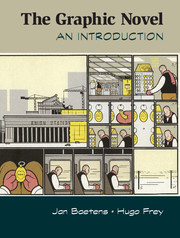Book contents
- Frontmatter
- Contents
- List of illustrations
- Acknowledgments
- 1 Introduction: The Graphic Novel, a Special Type of Comics
- Part One Historical Context
- Part Two Forms
- Part Three Themes
- 8 The Graphic Novel and Literary Fiction: Exchanges, Interplays, and Fusions
- 9 Nostalgia and the Return of History
- 10 A Short Bibliographical Guide
- Notes
- Index
9 - Nostalgia and the Return of History
Published online by Cambridge University Press: 05 October 2014
- Frontmatter
- Contents
- List of illustrations
- Acknowledgments
- 1 Introduction: The Graphic Novel, a Special Type of Comics
- Part One Historical Context
- Part Two Forms
- Part Three Themes
- 8 The Graphic Novel and Literary Fiction: Exchanges, Interplays, and Fusions
- 9 Nostalgia and the Return of History
- 10 A Short Bibliographical Guide
- Notes
- Index
Summary
It seems that wherever one looks in our contemporary culture, including to the world of graphic narratives, history and nostalgia are a common theme. After the post-modernism and the “end of history” of the early 1990s, the past has maybe never been as popular as it is today. Here we want to make a further contribution to the ongoing debate on the meaning of the dominance of the past in the present in the field of graphic narratives, and more specifically in the graphic novel. For us, when discussing the graphic novel, several aspects stand out and merit analysis and further consideration First, on the face of it, the rise of the graphic novel has reflected and contributed to the wider culture of nostalgia. Graphic novelists are talented at generating sophisticated treatments on history, and many of the most prominent exponents have been drawn to this subject. Certainly, it is also the case that along with the appearance of “all of this history,” underneath the real issue at stake is how selection processes work, the reorderings that bring some material back into fashion and leave other work behind. Second, nostalgia-inspired graphic novels can look formulaic. More importantly, reprinting or playing with old comics pose some creative problems as much as original solutions. Some of the old comics display value systems that are dated and inappropriate; putting works in museums poses difficult questions of how to display narrative sequence. Third and finally, the graphic novel can represent a pulling away from the conventional formulations and dilemmas associated with cultures of nostalgia. In this last chapter we explain how important and influential creators Spiegelman, Baker, Clowes, Backderf, Ware, and others provide a more complex and nuanced set of discourses on history. Their work is a sophisticated, and at times radical, treatment of the past when compared to other material from within the otherwise predictable fashion for anything vintage.
- Type
- Chapter
- Information
- The Graphic NovelAn Introduction, pp. 217 - 245Publisher: Cambridge University PressPrint publication year: 2014



